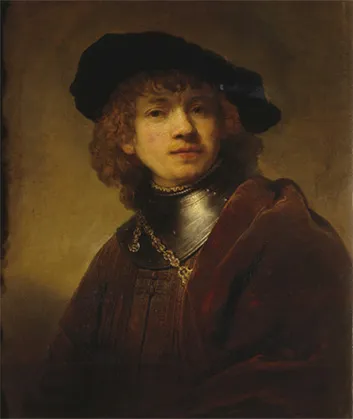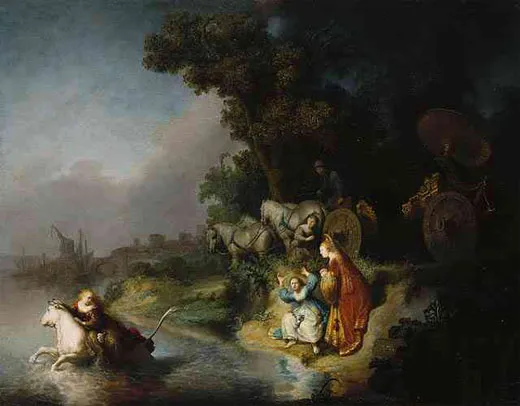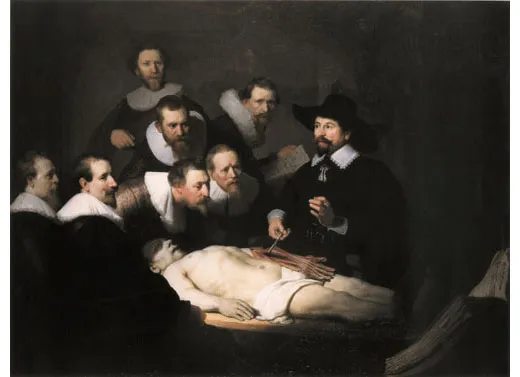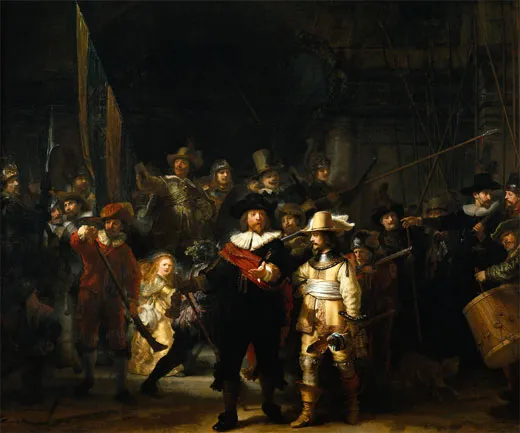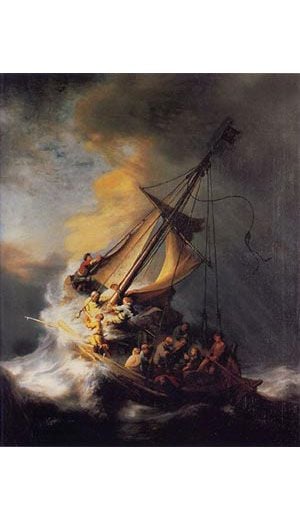Rembrandt at 400
Astonishing brushwork, wrinkles-and-all honesty, deep compassion. What’s the secret of his enduring genius?
Had you traveled through any major city in the Netherlands this year, you would likely have met the piercing gaze of a rather startling face. The wild-haired, wide-eyed character who greeted you from street signs, store windows, magazine covers and chocolate boxes is Rembrandt van Rijn (1606-69), master painter of the Dutch Golden Age. Rembrandt's incomparable art has always been a major selling point for Dutch tourism, but his self-portrait was everywhere in 2006 because Hollanders were celebrating the 400th birthday of their nation's most famous artist. In fact, Rembrandt 400, a yearlong national event under the patronage of Queen Beatrix, touched off a worldwide celebration involving museums and cultural institutions from Krakow to Melbourne. Among American institutions taking part is the National Gallery of Art in Washington, D.C., where "Strokes of Genius: Rembrandt's Prints and Drawings" will be on view through March 18, 2007.
All this attention reflects our enduring fascination with an artist whose works remain as moving and meaningful today as they were four centuries ago. Rembrandt is appreciated both for his expressive technique and his ability to capture the emotional heart of any character or story. His subject matter ranges from the biblical past to the people and places around him, but the central motif of his art—and a major reason his work continues to speak to us centuries after his death—is the human figure, rendered with sensitivity both to the telling imperfections of surface appearance and to the turbulence of the spirit within.
There is little doubt that Rembrandt would have approved of the current use of his own distinctive face as a marketing tool. He painted, etched and drew some 70 self-portraits, more than any other well-known artist of his time. By making his face the centerpiece of his art, he engaged in a uniquely personal means of self-marketing. Dressed in costume or assuming provocative poses, he played roles ranging from beggar and prodigal son to courtier and Oriental potentate. In small prints from his early years, he mugged in a mirror and sketched the results to teach himself the art of depicting emotion. Later in life, in closely observed paintings such as his warts-and-all Self-Portrait of 1659, he unflinchingly recorded the marks of time and experience. These works found their way into collections all over Europe, helping to make Rembrandt the most widely known Dutch artist of the 17th century.
Rembrandt van Rijn was born on July 15, 1606, in Leiden, the ninth child of miller Harmen Gerritszoon van Rijn and his wife, Neeltgen van Zuytbrouck. The family operated a grain mill on the Rhine River, which bordered the city. They were prosperous, working-class people, and their children would have been expected to join the mill business, as several of Rembrandt's siblings did, or take up a trade. Rembrandt must have shown some special promise, for his parents enrolled him in the Latin School, where he was introduced to classical languages and literature. Such an education should have led to the ministry or public service, but according to 17th-century Leiden historian Jan Orlers, Rembrandt was more interested in doodling than studying, and his parents, perhaps yielding to the inevitable, let him train with a local painter and then sent him to study for six months with an artist in Amsterdam.
Half an hour's train ride from Amsterdam (or a few hours by foot, horse or boat in Rembrandt's day), Leiden today is dominated by its university, which was founded in 1575. In the 17th century, the city owed much of its prosperity to the textile trade. The Municipal Museum De Lakenhal occupies a building that was once a guildhall, where governors and assayers of the cloth industry held their meetings. Several major exhibitions took place there in 2006, including a survey of Rembrandt's landscapes. While some of the paintings in that exhibition depict the countryside near his home, others are pure fantasy. In The Mill, for instance, an imposing windmill perches atop a rugged cliff distinctly unlike the flat terrain of Holland. Another exhibition, "Rembrandt's Mother, Myth or Reality," focused on two elderly figures who appear repeatedly in Rembrandt's earliest works. Nineteenth-century scholars, eager to romanticize the artist's life, were quick to identify them as Rembrandt's mother and father, while studies of younger figures were assumed to represent his brothers and sisters. Although modern scholars are more skeptical (there are no documents verifying these identifications), it makes sense that family members would be the most available—and affordable—models for an artist just starting out.
The signature style of the early Rembrandt school, based on precise observation from life combined with exotic historical costuming, can be traced to works such as Rembrandt's Tobit and Anna (1626), opposite, for which his mother and father may have modeled. In such small, meticulous paintings, we catch a glimpse of the young artist carefully training his eye, while developing a fascination with old age that would resurface throughout his career.
By the time he reached his mid-20s, Rembrandt was already gaining international attention. While most of his Dutch contemporaries sold their work locally, his paintings and prints were being collected not only in Holland but in Italy, France and elsewhere. Around 1630, King Charles I of England received three paintings by Rembrandt as a gift, including a self-portrait and a painting that is thought to be of the artist's mother. In search of wider opportunities than his hometown could offer, Rembrandt moved in the early 1630s to Amsterdam, a city of about 125,000 inhabitants and then, as now, the cultural and commercial hub of the Netherlands.
Rembrandt's Holland was unique in Europe: a republic led by citizens, not a monarchy, with a booming trade economy in which hard work and entrepreneurship counted more than a noble title. It was a place where religious diversity was tolerated and where urban, middle-class taste dominated cultural life. Amsterdam was the center of a lively art market, and as soon as Rembrandt arrived there, a business partnership with Hendrick van Uylenburgh, a prominent art dealer, brought the artist some of his first portrait commissions—a foot in the door to patronage from Amsterdam's wealthiest citizens.
With van Uylenburgh's help, Rembrandt quickly became the most sought-after portraitist in Amsterdam. His brilliant Portrait of Agatha Bas, painted in 1641, shows why. The 30-year-old Agatha, a wealthy burgomaster's daughter and wife of one of van Uylenburgh's investors, regards us with a demure yet confident gaze. Her left hand rests on a polished wood embrasure, while the elegant fan in her right hand drops in front of it. Is this a window frame, or the frame of the picture itself? This illusion, along with the direct pose, life-size scale and subtle play of light behind the figure, creates the sense that we are face to face with another living soul. Look closer, however, and the lifelike details of her frizzled hair, embroidered bodice, sparkling jewels and lace-trimmed collar dissolve into dashes and strokes of paint, with translucent glazes of color layered over thick impasto. This magical combination sets Rembrandt apart from the smoother, more polished technique favored by many of his contemporaries.
In 1634, when he was 28, Rembrandt married van Uylenburgh's 21-year-old cousin, Saskia. She, too, was a frequent model for the artist, who cast her in picturesque roles such as Flora, the goddess of spring. In an intimate silverpoint drawing of Saskia that Rembrandt made just days after their engagement, she wears a sun hat trimmed with flowers and smiles shyly. During their eight years of marriage, the couple had four children, but only one, Titus, would survive infancy. In 1642, less than a year after Titus' birth, Saskia died at age 29, from illness or complications of childbirth. Her will stipulated that Rembrandt would benefit from her estate provided he didn't remarry. He had an affair with Geertje Dircx, a nurse brought in to care for the baby boy, then some years later rejected her for a younger woman, Hendrickje Stoffels, who had joined the household as a maid. Dircx sued him for breach of promise, provoking a long and bitter legal battle.
In 1654 Stoffels was called before the elders of her church and accused of "living in whoredom with the painter Rembrandt," but she stayed with him despite the scandal. Their daughter, Cornelia, was born later that year. Both Stoffels and Titus helped with Rembrandt's business (Titus would grow up to be a minor artist and his father's agent), and the boy was likely the model for several of the artist's evocative figure studies, including Titus at His Desk, painted in 1655. With a few swift strokes, Rembrandt captures the textures of cloth, hair, wood and paper, as well as the reverie of a schoolboy who would rather be anywhere but at his desk. Stoffels posed also: a sensitive portrait of her at about age 34 is at New York's Metropolitan Museum of Art.
For nearly 20 years, Rembrandt filled his spacious home on the Sint Anthonisbreestraat in Amsterdam with the bustle of students at work, clients coming to call and paintings and prints for sale. He also amassed a collection of objects that included not only works of art but Amazonian parrot feathers, Venetian glassware, African lion skins and other exotic treasures, some of which provided motifs for his paintings. Never a good money manager, he failed to meet the mortgage payments and lost the house after he went bankrupt in 1656. The inventory of his art collection recorded at that time shows that he took an interest in the work of predecessors such as Dürer and Titian, as well as such Flemish contemporaries as Rubens and Van Dyck. The Rembrandt House (a private home until 1906, when it was purchased by the city of Amsterdam) opened as a museum in 1911.
In 1642 Rembrandt completed his most famous painting, the huge group portrait known as The Night Watch, which depicted a company of civic guardsmen marching out to defend their city. (The painting has been the star attraction at Amsterdam's Rijksmuseum since its installation in 1885.) Amsterdam in 1642 was, in fact, a peaceful and prosperous city, and the civic guard served more as a social club for ambitious citizens than a true military force. Rembrandt's imagined scene is a symbolic enactment of their proud readiness to serve. What makes this painting revolutionary is that Rembrandt took what could have been a boring row of figures and turned it into a lively action scene. One contemporary said that it made other group portraits look as flat as playing cards. Over the centuries, The Night Watch has been trimmed to fit a tight location, rolled up and stashed in a bunker to protect it from the Nazis, slashed with a bread knife (in 1975), sprayed with acid by a deranged museum visitor (in 1990) and interpreted on beer steins, on T-shirts and in the works of modern artists. But thanks to Rembrandt's bold invention and to the guardsmen's portrayal of the patriotic spirit on which the nation was founded, it has never lost its status as a Dutch national icon.
For some admirers of Dutch art, Rembrandt competes with van Gogh for the title of favorite son. But this year even Amsterdam's Van Gogh Museum hosted a blockbuster Rembrandt show— "Rembrandt-Caravaggio." The Italian master Caravaggio, who died in 1610 when Rembrandt was only a child, is best known for his treatment of biblical subjects with a rugged truth to nature, enhanced by dramatic light. His revolutionary approach sparked an international movement that reached Rembrandt (who never left Holland) through Dutch artists who traveled to Rome. The 2006 show compared the two masters' treatments of several related themes, but we don't have to look far to find evidence of Rembrandt's interest in Caravaggio's ideas, particularly his notion of biblical stories as emotional dramas enacted by people who still strike us as profoundly human.
A moving example from Rembrandt's later years is his 1656 Jacob Blessing the Sons of Joseph (above right). Here, we see the patriarch Jacob, ailing and nearly blind, as he reaches out to bless his two grandsons. Jacob extends his right hand to the younger brother, Ephraim, not to the elder, Menasseh. Rembrandt follows the text in Genesis as he depicts the boys' father, Joseph, gently trying to shift the patriarch's hand. But the old man is adamant, his action prophetic: he knows that the younger son is destined for greatness. Quietly watching is the boys' mother, Asenath. Her presence is not mentioned in the relevant passage, but she is named elsewhere in Genesis, as Rembrandt clearly knew. By including her in the picture, the artist emphasizes that this is, at heart, a family crisis. (He may, in fact, have painted this work for a Dutch family, each member standing in for a biblical character.) Despite the moment's fateful consequences, we sense, above all, the profound love and faith shared by three generations, enclosed in an intimate circle of light. While the strong play of shadow owes something to Caravaggio, the thick, almost sculptural surface of the paint, applied with strokes that are broad and quick but still marvelously descriptive, is Rembrandt's alone—his most original contribution to the history of technique.
For many modern viewers, this is Rembrandt at his best, but in his own time, his rough paint surfaces, dramatic lighting and pensive, down-to-earth characters increasingly set him apart from prevailing trends. Toward the end of his life, a taste for ideal beauty was sweeping Europe, and Dutch connoisseurs were demanding elegant figures and settings, clear light and refined technique. For refusing to conform to this fashion, Rembrandt was labeled in 1681 by dramatist Andries Pels as "the first heretic in the history of art." To Pels and other proponents of classicism, Rembrandt's expressive handling of paint seemed sloppy and unfinished. Yet, according to 18th-century biographer Arnold Houbraken, Rembrandt maintained that "a work is finished when the master has achieved his intention in it." Another target for critics was his treatment of the nude. While classicists argued that artists should aspire to the cool perfection of Greek sculpture, Rembrandt assiduously recorded his subjects' wrinkles and garter marks, knobby knees and wispy hair. For this, he was accused of failing to master the rules of proportion and anatomy.
Rembrandt was no less the nonconformist in his dealings with clients. Most artists welcomed them in their studios, but Rembrandt was gruff. If a prospective buyer tried to look at a painting too closely, Houbraken writes, Rembrandt would shoo him away, warning that "the smell of the oil paint will make you sick." In a notarial document of 1654, a Portuguese merchant named Diego d'Andrada complained to Rembrandt that the portrait of a girl he had ordered looked nothing like her. He wanted the artist to change it or return his deposit. Rembrandt told the notary that he wouldn't touch the painting until D'Andrada paid the balance due. Then, he said, he would submit it to the directors of the painters' guild for their judgment and would make changes only if they agreed with the client. If D'Andrada still wasn't satisfied, Rembrandt would keep the painting and sell it at auction. There was no mention of returning the deposit. How the case was resolved is unknown, but Rembrandt's attitude was as risky as it was courageous. It surely cost him some business, but in the long run, his enduring impact owes much to his creative independence, a mark of the "modern" artist.
By the time he died at 63 in 1669, Rembrandt had sold paintings and prints to distinguished collectors throughout Europe, trained dozens of students, made and lost a fortune, and created some of the 17th century's most memorable works. While his bold, unconventional approach to both life and art has been admired by some viewers more than others, the fundamental authenticity of his response to the human condition remains unquestioned. In Rembrandt's Eyes, an eloquent study of the artist and his milieu, the cultural historian Simon Schama observes that for Rembrandt, "imperfections are the norm of humanity. Which is why he will always speak across the centuries to those for whom art might be something other than the quest for ideal forms."
Stephanie Dickey teaches art history at Queen's University in Kingston, Ontario, and is the author of three books on Rembrandt.
